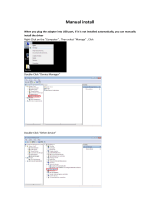
iiD-Link DAP-3520 User Manual
Table of Contents
Preface...........................................................................i
Manual Revisions ..................................................... i
Trademarks .............................................................. i
Product Overview ........................................................ 1
Package Contents ...................................................1
System Requirements .............................................2
Introduction ..............................................................3
Features .................................................................. 4
Four Operational Modes ..........................................5
Connecting PoE (Power over Ethernet) ..................6
Hardware Overview .................................................7
Connections ....................................................... 7
Conguration ............................................................... 8
Web-based Conguration Utility ..............................8
Wireless Settings .............................................11
WDS with AP mode ..................................... 13
WDS mode ...................................................15
Wireless Client Mode ................................... 17
WEP Encryption ............................................... 19
WPA-Personal Authentication ......................... 20
WPA-Enterprise Authentication ....................... 21
LAN ................................................................. 22
Advanced Settings ........................................... 23
Performance .................................................23
Multi-SSID ....................................................25
VLAN ...............................................................28
Port List ........................................................29
Add/Edit VLAN .............................................30
PVID Setting .................................................31
Intrusion ........................................................... 32
Schedule .......................................................... 33
QoS .................................................................. 34
DHCP Server ................................................... 36
Dynamic Pool Settings .................................36
Static Pool Setting ........................................38
Current IP Mapping List ...............................40
Filters ............................................................... 41
Wireless MAC ACL ......................................41
WLAN Partition .............................................42
Status ............................................................... 43
Device Information ....................................... 43
Client Information .........................................44
WDS Information ..........................................45
Stats ................................................................. 46
Ethernet ........................................................46
WLAN ...........................................................47
Log ................................................................... 48
View Log ......................................................48
Log Settings .................................................49
Maintenance .................................................... 51
Administrator Settings ..................................51
Limit Administrator .......................................52
System Name Settings ................................. 53





















